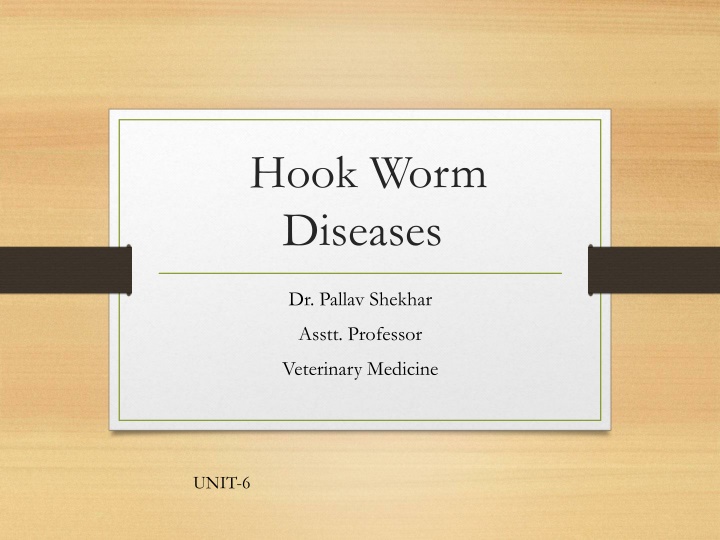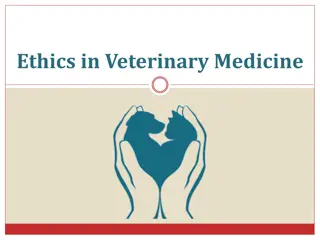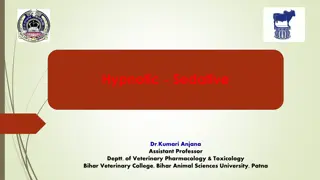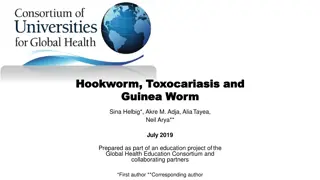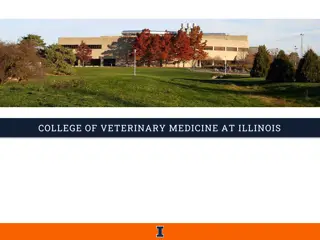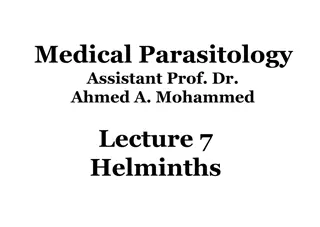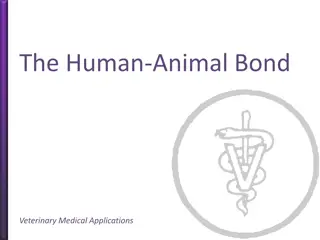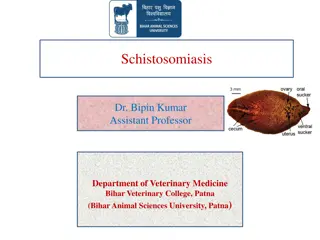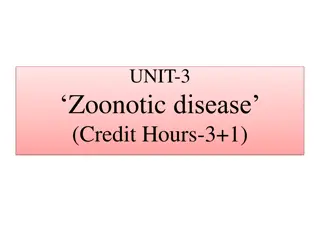Overview of Hookworm Diseases in Veterinary Medicine
Hookworm diseases, such as Bunostomiasis, are common in young animals like calves, causing emaciation, anemia, and death. Etiology involves Bunostomum phlebotomum in cattle and B. trigonocephalum in sheep and goats. The disease is globally prevalent, more so in tropical regions, and is transmitted through skin penetration. Clinical findings include diarrhea, anemia, and abdominal pain. Diagnosis involves identifying eggs in feces, and treatment includes benzimidazoles and supportive care with hematincs and mineral mixtures.
Download Presentation

Please find below an Image/Link to download the presentation.
The content on the website is provided AS IS for your information and personal use only. It may not be sold, licensed, or shared on other websites without obtaining consent from the author.If you encounter any issues during the download, it is possible that the publisher has removed the file from their server.
You are allowed to download the files provided on this website for personal or commercial use, subject to the condition that they are used lawfully. All files are the property of their respective owners.
The content on the website is provided AS IS for your information and personal use only. It may not be sold, licensed, or shared on other websites without obtaining consent from the author.
E N D
Presentation Transcript
Hook Worm Diseases Dr. Pallav Shekhar Asstt. Professor Veterinary Medicine UNIT-6
Bunostomiasis or Hook Worm Disease This disease is characterized by emaciation, progressive anemia, constipation followed by diarrhea and death in young animals.
Etiology Cattle- Bunostomum phlebotomum Sheep and goat- B. trigonocephalum
Epidemiology The disease is world wide in occurrence and is more common in tropical countries. Calves in the age group of 4-12 months are commonly affected. The disease is transmitted mainly through skin penetration
Life cycle-Direct Alveoli L4 stage Heart and lung Egg laying Enter in blood Feces Pharynx Adult worm Cutaneous penetration Lumen of S.I L1 Swallowed L3 stage infective Penetrate Mucosa L2 S.I
Pathogenesis Active blood sucking are the major cause of anaemia in all species. Total worm as low as 100 may cause clinical illness and 2000 may cause death in young cattle. Hypoprotenemic oedema, bottle jaw and some irritation of intestinal mucosa leads to mild diarrhoea Penetration of skin leads to irritation and itching.
Clinical findings Stamping and licking of feet. Constipation accompanied by abdominal pain followed by bouts of diarrhoea. Pale mucous membrane Presence of occult blood in feces Oedema of lower abdominal part
Diagnosis Identification of eggs in feces and coproculture are most detectable method of diagnosis. Other methods like clinical symptoms like anaemia, diarrhoea and anasarca. Necropsy is the only certain method of diagnosis i.e hook worms attached to the mucosa of small intestine and intestinal content are deeply blood stained.
Treatment BENZIMIDAZOLE EFFECTIVE AGAINST ADULT AVERMECTIN BUNOSTOMUM Sp. Sheep & cattle LEVAMIZOLE but are not effective against larval MORANTEL larval stage NOTROXYNIL AND RAFOXANIDE ARE EFFECTIVE AGAINST IMMATURE WORM SUPPORTIVE TREATMENT LIKE HEMATINICS AND MINERAL MIXTURE CONTAINING FE, CU, CO ARE ESSENTIAL AS ANAEMIA IS THE MAIN CAUSE OF DEATH.
Hook worm disease of dog and cat Ancylostoma caninum Characterized by poor growth and anaemia and are most widely distributed hook worm of pet and zoo animals. All breeds and young ones are highly susceptible. All breeds and young ones are highly susceptible Ancylostoma brazilliensis Found in S.I of dog, cat, leopard, foxes and human being
Ancylostoma tubaeformis Found in cats A. duodenale Found in man and also in dog and cats. Nectar americanus Common in man Uncenaria stenocephala Found in dog, act and foxes
Transmission By ingestion By penetrating the skin Transplacental Transcolostral
Pathogenesis L2 L1 and L2 stage Adult worm Egg Hatch Twice stage infective L3 Larvae in lung capillaries lung heart blood Penetrate skin development Rupture capillaries Enter into lung alveoli Crowl in resp. tract L4 stage Cough up Re-swallowed Eggs Adult intestine
Pathogenesis L2 stage Directly into G.I tract Penetrate skin Colostrum Placenta Adult ******* G.I. Tract Foetus Prenatal infection
Cont.. Migratory larvae doesn t cause much damage. Adult parasites are harmful as they are active suckers and cause severe anaemia and also haemorrhage in intestine.
Clinical Findings Severe anaemia and sudden death in acute condition. In moderate condition , pale mm, anaemia, emaciation, stunted growth, mild diarrhoea, melena and itching of skin. Red bite mark in the lower abdominal region.
Diagnosis Diagnosis- Fecal examination D/D- Leptospirosis Coccidiosis Canine Babesiosis Canine Ehrlichosis
Treatment Mebendazole-22mg/kg daily orally for 5 days Pyrantel- 6-15mg/kg commonly in human beings Albendazole- 25mg/kg for 3 consecutive days Supportive Medicine- Blood transfusion, hematinic.
